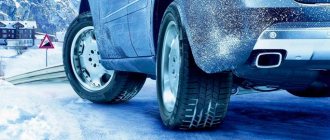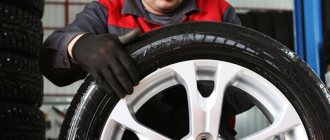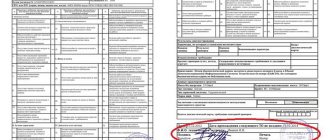Tread - wear rate
Car tires inevitably wear out over time. The wear rate of a car tread is influenced by many factors:
- operating conditions and technical condition of the vehicle;
- road surface condition, weather conditions;
- driving style;
- vehicle mileage;
- tire manufacturer;
- price range of products.
Measuring the thickness of the tread layer will allow you to accurately determine the degree of tire wear and make a timely decision to replace unsuitable tires with new ones.
The effect of tire wear on driving
Over time, the tread of car tires wears out, which invariably worsens vehicle control and significantly reduces its stability. It is known that on wet asphalt or soil, the braking distance increases if the tires are significantly worn. In this regard, many manufacturers make the tread pattern and depth in such a way as to significantly shorten the braking distance.
Also, on a wet road surface, worn-out tires can cause an accident. If the tread depth is below the permissible value, aquaplaning may occur. It occurs due to the fact that the rear and front wheels begin to rotate at different speeds. One of the front wheels ends up on the surface of the water, thereby losing traction with the road surface, causing the car to skid while driving. This may result in the driver losing control of the vehicle and causing an accident. Worn tires can cause:
- difficult control in bad weather;
- increasing braking distance on ice, snow or wet roads;
- deterioration in braking quality due to reduction in wheel weight.
You should not assume that worn-out tires only worsen vehicle performance in rainy weather and snowfall. When driving on a dry road, vehicle stability is significantly reduced (primarily this applies to vehicles without EPS systems responsible for directional stability).
Tire manufacturers pay special attention to the quality of winter tires. At the same time, depending on the type of vehicle, the tread pattern and thickness are carefully thought out, the rubber composition is selected, which together ensures the effective removal of dirt and slush from the point of contact of the rubber with the road surface, which, in turn, affects the quality of control. High-quality winter tires, even without special studs, are able to provide the necessary grip on the asphalt or soil surface.
See also: Medical certificate for a driver’s license - how and where to apply, how much does it cost?
Traffic rules: for safety reasons
Different tires have different wear limits. Tread depth affects vehicle handling and road safety. According to Chapter 5 of the Traffic Regulations, maximum standards for the height of the tread pattern are established. For category M1 - passenger cars, as well as vehicles of categories N1, O1 and O2, the minimum permissible value is 1.6 mm. When operating winter tires on snowy or icy surfaces, the limit is 4 mm. A traffic police officer has the right to measure the residual depth with a verified device. If a violation is detected, a fine is imposed on the car owner.
Optimal tread depth control value
The permissible tread depth of winter tires for a passenger car is considered one of the most important indicators that allows you to determine the possibility of using tires for a particular car and driving in certain conditions. If the minimal tread on your winter tires wears out, you will need to replace the tires as traction may deteriorate.
The Road Traffic Rules prescribe the remaining tread depth of winter tires at which driving the vehicle will be safe and will not lead to an emergency. During operation, tires become bald, which leads to skidding on turns and slippery roads. Continued use of such tires may lead to unpleasant consequences on the road. If the tread height of winter tires according to traffic regulations is not observed, the motorist will have to pay a fine.
The minimum tread height of winter tires will also depend on the function of the wheels of a particular car, so tires can be divided into:
- Road;
- Regional;
- Off-road;
- Sports.
The tread depth of new winter tires will depend on the manufacturer and type of rubber. The average value will vary between 8 - 10 mm. The optimal tread size is calculated by a special program. The texture of winter tires will be deeper than that of summer models. Classic winter tires can have a tread depth of 8.5 - 9.5 mm, and for SUVs and sports cars this figure will be 17 mm. It is also important to consider the purpose of the rubber for use in certain road or weather conditions.
The main task of such tires is to ensure maximum cross-country ability on mud, soil, sand, snowy sections of the road, etc. These products feature a powerful pattern with deep channels to provide reliable traction on powdery snow and ice. Also, tires with sipes and studs must remove water and snow slush from the contact patch with the road. Directional and deep longitudinal channels help with this.
Any tires tend to wear out over time. When asked what tread height should be the minimum allowable, winter tire manufacturers cite the figure as 4 mm. In order for tires to perform their functions at the proper level, and their grip qualities not to decrease, it is worth replacing worn-out tires in a timely manner if they become “bald”, covered with cracks or other defects. The integrity of tires should be checked in a timely manner.
Summer tires
The new summer tire has an average tread depth of 7-8 mm. The service life of summer tires is, as a rule, 3-5 seasons with average mileage and moderate driving style. The legal limit on residual height is 1.6 mm. However, with 3 mm of the outer layer remaining, the car is already difficult to control, grip deteriorates, and a safety hazard arises. You should not wait to reach a critical value. Make sure to change your tires in advance.
Winter tires
Winter tires are used in harsh weather conditions: low temperatures, icy conditions, snowy road surfaces. Worn elements make the tire ineffective on slippery winter roads. Accordingly, a more serious approach to the condition of tire tread is needed. Studless friction rubber (Velcro) initially has a tread height of 8-9 mm. The new studded tire is from 9 to 11 mm; some companies produce a tread height of 12-18 mm. When the tread wears down to 4-5 mm, winter tires require replacement. In addition, the loss of more than 50% of metal studs is also a reason to change your car's shoes. The average service life of winter tires is 2-4 years.
All-season tires
The universal all-season vehicle is used in temperate climates both in winter and summer, optimal at temperatures from +10 to -10˚C. Such tires are not suitable for use in snowfall or severe frosts. Traffic regulations allow the use of all-season tires in winter if they have special markings:
- a sign in the form of a mountain peak with a snowflake inside;
- M+S;
- M&S.
All-season tires last on average 3-4 years. In summer, when temperatures are high, all-weather tires wear out much faster. It is recommended to buy new tires when the tread layer has worn down to 2-2.5 mm.
The wheel has rolled
The corresponding bill was prepared by the Department of Road Safety of the Ministry of Internal Affairs of Russia. It was developed by order of the President, which indicated the need to establish uniform requirements in government regulations regarding the use of car tires when operating vehicles.
It can be assumed that the whole problem was in the Gazelles. The fact is that the rules of the road, in particular the provisions for authorization for the operation of vehicles, stipulate that the tires of passenger cars have a residual tread depth of less than 1.6 mm, trucks - 1 mm, buses - 2 mm, motorcycles and mopeds - 0.8 mm.
"Gazelle", as well as the Korean Porter, are category "B" cars. Their maximum weight does not exceed 3.5 tons. That is, the tread depth should be 1.6 mm. However, in all other respects, these are trucks. They are designed for transporting goods. That is, they can roll tires down to one millimeter?
According to the requirements of the technical regulations on the safety of wheeled vehicles of Russia, according to the requirements of the same regulations of the Customs Union, they remain trucks. Category N1 - vehicles intended for the transportation of goods, having a maximum weight of no more than 3.5 tons.
In general, everything is very complicated with the classification of vehicles. What, for example, include pickup trucks? They also belong to category N1 in both international and Russian qualifications, despite the fact that many of them can be driven with an open category “B” license. Here cars are already divided according to their functionality. By the way, many pickup trucks are prohibited from entering the city center without the appropriate pass: the carrying capacity is more than a ton. Many of them can be driven with a category “C” license; their maximum weight is more than 3.5 tons.
Now, in accordance with the instructions of the President, the Ministry of Internal Affairs has decided to indicate the tread depths for each vehicle. For vehicles of category L - these are all mopeds, motorbikes, motorcycles, as well as motorcycles, scooters and even tricycles and quadricycles - the residual tread depth is set to at least 0.8 mm.
For vehicles of categories N2, N3, O3, O4 - these are trucks and trailers, the maximum weight of which is over 3.5 tons - 1.0 mm.
For vehicles of categories M1, N1, O1, O2 - these are passenger cars, as well as trucks, the maximum weight of which does not exceed 3.5 tons, as well as trailers for them, which also do not exceed this weight - 1.6 mm.
For vehicles of categories M2, M3 - these are buses, that is, everything with more than eight passenger seats - 2.0 mm.
For the first time, the Basic Regulations for the admission of vehicles to operation spell out the requirements for winter tires and explain which tires are considered such.
The remaining tread depth of winter tires intended for use on icy or snowy road surfaces during operation on said surface is no more than four mm. Please note that we are talking specifically about their use in snowy or icy areas.
Winter tires are marked with a symbol in the form of a mountain peak with three peaks and a snowflake inside it, as well as the symbols “M+S”, “M&S” and “MS”. If the tire has wear indicators, then there is no need to measure the tread depth with a caliper.
What penalties will be provided for this is still unknown. It is clear that tires that do not meet these requirements will not pass inspection.
It is not yet clear whether penalties will be introduced on the roads. As the traffic police told us, we first need to introduce requirements, and then think about fines.
Methods for measuring tread depth
You can estimate the remaining tread layer in various ways:
- Special volumetric indicators in the form of jumpers: if the tread layer wears down to the level of the jumpers, the tire is not suitable for further use.
- Manufacturers stamp numbers of varying depths on the surface of some types of tires. Wear is assessed visually, by the visibility of individual numbers.
- Using measuring instruments: from a metal ruler, caliper or depth gauge to an electronic tread depth gauge.
Measuring the tread remaining on winter tires
The minimum tread depth on winter tires is regulated by the Road Traffic Regulations to ensure that accidents do not occur due to non-compliance with this requirement. If worn tires are not replaced on time, the car owner may pay a fine after the traffic police inspector checks the tread depth with a special device. Tires should not be worn more than fifty percent of their original height. Most manufacturers have provided a special mark (wear indicator) so that car owners can check this indicator. Also for similar purposes, professional instruments and improvised means are used (a coin placed edgewise in a tread groove, a ruler or caliper with a depth gauge, etc.).
It is important that the tread pattern height is uniform over the entire surface of the product. A special indicator (colored layer) can indicate that the tires need to be replaced. Wear levels are measured across the entire width and circumference of the tire. If the product wears unevenly, you need to check the adjustment of the wheel angles for camber and toe. It is also worth conducting a visual inspection to determine the condition of the tires. If the tire has cuts, cracks, cord breaks, mechanical damage and other reasons for compromising the integrity of the tread or sidewalls, it is worth replacing such a part. It is especially important to replace the tires on the drive wheels in a timely manner, as well as install new tires on the same axle at the same time.
Factors that lead to rapid wear of tires and the possibility of restoring such products
Excessive wear of passenger car tires in winter can occur for the following reasons:
- Natural wear of tires due to loads and intensive use;
- Incorrect alignment of wheels and tires, leading to uneven wear;
- Inconsistency with the seasonality of tires;
- High mileage;
- Incorrect type of tires;
- Driving too fast on ice, potholes and off-road conditions;
- Aggressive driving style;
- Lack of control of correct tire pressure.
If a part becomes obsolete, its resource will be exhausted and the tire will need to be replaced. Manufacturers indicate an approximate tire service life of 10 years, but in fact these products should be replaced after six seasons of use. You should also pay attention to the importance of maintaining optimal tire pressure levels in any season. This indicator will depend on the load on your transport and the number of passengers.
All tires have a certain service life for which they are designed. However, there are cases when this period can be extended using professional methods (cold and hot welding, cutting method to increase the depth of the pattern). The groove depth can be increased by 3-4 mm. by cutting, if the tires are marked “Regroovable”. You can also retread your tires by adding an extra layer of rubber. The cold welding method involves heating the product to 100 °C, and the hot welding method - to 120-160 °C. Professional technicians with experience in this type of work use reliable equipment and take into account the age of the tire, its appearance, as well as the integrity of the cord and the presence of defects. Correct use of restoration methods will increase mileage by 40%.
Buying tires: new or used
Old tires have become unusable, the amount of tread remaining is approaching a critical point - there is no need to take risks, it’s time for your car to change its shoes. Do you want to spend little money and buy used tires? Be careful! Sellers indicate in their advertisements the condition of used tires as good or excellent. Don’t be too lazy to measure the height of the tread layer yourself. And remember: for winter tires, a value of 4 mm is already 100% wear. The quality of domestic roads, unfortunately, does not allow tires to be used for 7-10 years. Purchasing used car tires is always a risk of buying products with extreme wear.
Don't skimp on safety. Buying new tires will require a larger investment, but will pay off with a long period of trouble-free operation.











